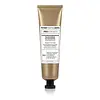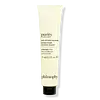What's inside
What's inside
 Key Ingredients
Key Ingredients

 Benefits
Benefits

 Concerns
Concerns

 Ingredients Side-by-side
Ingredients Side-by-side

Salicylic Acid 2%
MaskingWater
Skin ConditioningAlumina
AbrasiveBentonite
AbsorbentKaolin
AbrasiveMaltodextrin
AbsorbentPropanediol
SolventGlycerin
HumectantAloe Barbadensis Leaf Juice
Skin ConditioningCitric Acid
BufferingTitanium Dioxide
Cosmetic ColorantZinc Oxide
Cosmetic ColorantPhenoxyethanol
PreservativePolyacrylate Crosspolymer-6
Emulsion StabilisingPolysorbate 20
EmulsifyingProtease
ExfoliatingPotassium Sorbate
PreservativeSodium Benzoate
MaskingT-Butyl Alcohol
PerfumingTriethoxycaprylylsilane
Sodium Hyaluronate
HumectantEthylhexylglycerin
Skin ConditioningSalicylic Acid 2%, Water, Alumina, Bentonite, Kaolin, Maltodextrin, Propanediol, Glycerin, Aloe Barbadensis Leaf Juice, Citric Acid, Titanium Dioxide, Zinc Oxide, Phenoxyethanol, Polyacrylate Crosspolymer-6, Polysorbate 20, Protease, Potassium Sorbate, Sodium Benzoate, T-Butyl Alcohol, Triethoxycaprylylsilane, Sodium Hyaluronate, Ethylhexylglycerin
Water
Skin ConditioningKaolin
AbrasiveSolum Diatomeae
AbrasivePropanediol
SolventBentonite
AbsorbentDecyl Glucoside
CleansingAlcohol Denat.
AntimicrobialLauryl Glucoside
CleansingPropylene Glycol
HumectantPolysilicone-11
Pvp
Emulsion StabilisingXanthan Gum
EmulsifyingSalicylic Acid
MaskingSodium PCA
HumectantSodium Citrate
BufferingCitric Acid
BufferingParfum
MaskingChlorphenesin
AntimicrobialLinalool
PerfumingDisodium EDTA
Limonene
PerfumingLaureth-12
EmulsifyingPhenoxyethanol
PreservativeGeraniol
PerfumingVanillyl Butyl Ether
MaskingEthylhexylglycerin
Skin ConditioningCI 77891
Cosmetic ColorantWater, Kaolin, Solum Diatomeae, Propanediol, Bentonite, Decyl Glucoside, Alcohol Denat., Lauryl Glucoside, Propylene Glycol, Polysilicone-11, Pvp, Xanthan Gum, Salicylic Acid, Sodium PCA, Sodium Citrate, Citric Acid, Parfum, Chlorphenesin, Linalool, Disodium EDTA, Limonene, Laureth-12, Phenoxyethanol, Geraniol, Vanillyl Butyl Ether, Ethylhexylglycerin, CI 77891
Ingredients Explained
These ingredients are found in both products.
Ingredients higher up in an ingredient list are typically present in a larger amount.
Bentonite is an aluminium phyllosilicate clay with great absorbent properties. The name 'bentonite' comes from the area where the largest source is found: Fort Benton, Wyoming.
As a clay, bentonite is often used to absorb excess oil and provide exfoliation. It has also been shown to have some antibacterial and anti-inflammatory properties. Studies show bentonite was effective at calming dermatitis from poison ivy and in diaper dermatitis of infants. Bentonite has also been shown to act as a barrier against toxic compounds on your skin.
Sunscreens containing bentonite display higher water resistance and stay on the skin for much longer. The sunscreens containing bentonite also show higher potency and UV light absorbtion.
Bentonite is naturally created from volcanic ash and several natural weathering/hydrothermal processes.
A common usage of bentonite is removing excess protein from white wines. Bentonite contains a property of being able to absorb large amounts of protein from aqueous solutions.
Phyllosilicate clay has a structure formed by sheets.
Learn more about BentoniteCitric Acid is an alpha hydroxy acid (AHA) naturally found in citrus fruits like oranges, lemons, and limes.
Like other AHAs, citric acid can exfoliate skin by breaking down the bonds that hold dead skin cells together. This helps reveal smoother and brighter skin underneath.
However, this exfoliating effect only happens at high concentrations (20%) which can be hard to find in cosmetic products.
Due to this, citric acid is usually included in small amounts as a pH adjuster. This helps keep products slightly more acidic and compatible with skin's natural pH.
In skincare formulas, citric acid can:
While it can provide some skin benefits, research shows lactic acid and glycolic acid are generally more effective and less irritating exfoliants.
Most citric acid used in skincare today is made by fermenting sugars (usually from molasses). This synthetic version is identical to the natural citrus form but easier to stabilize and use in formulations.
Read more about some other popular AHA's here:
Learn more about Citric AcidEthylhexylglycerin (we can't pronounce this either) is commonly used as a preservative and skin softener. It is derived from glyceryl.
You might see Ethylhexylglycerin often paired with other preservatives such as phenoxyethanol. Ethylhexylglycerin has been found to increase the effectiveness of these other preservatives.
Kaolin is a clay. It is used for oil control and to help minimize pores. Like other clays, kaolin has the ability to absorb excess sebum or oil. This can help clean out pores and mattify the skin.
Some types of kaolin may have exfoliating properties. When water is added to kaolin, it becomes a paste with small abrasive particles.
Most kaolin is a white color, but may be pink/orange/red depending on where it comes from.
The name 'kaolin' comes from a Chinese village named 'Gaoling'. Kaolin clay comes from rocks rich in kaolinite. Kaolinite, the mineral, has a silicate layered structure. Kaolinite is formed from chemical weathering of aluminum siilicate minerals.
Besides skincare, kaolin is commonly used to make glossy paper, in ceramics, toothpaste, and as medicine to soothe stomach issues.
Learn more about KaolinPhenoxyethanol is a preservative that has germicide, antimicrobial, and aromatic properties. Studies show that phenoxyethanol can prevent microbial growth. By itself, it has a scent that is similar to that of a rose.
It's often used in formulations along with Caprylyl Glycol to preserve the shelf life of products.
Propanediol is an all-star ingredient. It softens, hydrates, and smooths the skin.
It’s often used to:
Propanediol is not likely to cause sensitivity and considered safe to use. It is derived from corn or petroleum with a clear color and no scent.
Learn more about PropanediolSalicylic Acid (also known as beta hydroxy acid or BHA) is a well-known ingredient for treating skin that struggles with acne and clogged pores. It exfoliates both the skin's surface and deep within the pores to help clear out buildup, control oil, and reduce inflammation.
Unlike AHAs (alpha hydroxy acids), salicylic acid is oil-soluble. This allows it to penetrate into pores which makes it especially effective for treating blackheads and preventing future breakouts.
Salicylic acid is also known for its soothing properties. It has a similar structure to aspirin and can calm inflamed or irritated skin, making it a good option for acne-prone skin that is also sensitive.
Concentrations of 0.5-2% are recognized by the U.S. FDA as an over-the-counter topical acne product.
It can cause irritation and/or dryness if one's skin already has a compromised moisture barrier, so it's best to focus on repairing that before introducing this ingredient into your routine.
While salicylic acid does not increase sun sensitivity, it’s still important to wear sunscreen daily to protect your skin.
If you are looking for the ingredient called BHA or Butylated Hydroxyanisole, click here.
Learn more about Salicylic AcidWater. It's the most common cosmetic ingredient of all. You'll usually see it at the top of ingredient lists, meaning that it makes up the largest part of the product.
So why is it so popular? Water most often acts as a solvent - this means that it helps dissolve other ingredients into the formulation.
You'll also recognize water as that liquid we all need to stay alive. If you see this, drink a glass of water. Stay hydrated!
Learn more about Water